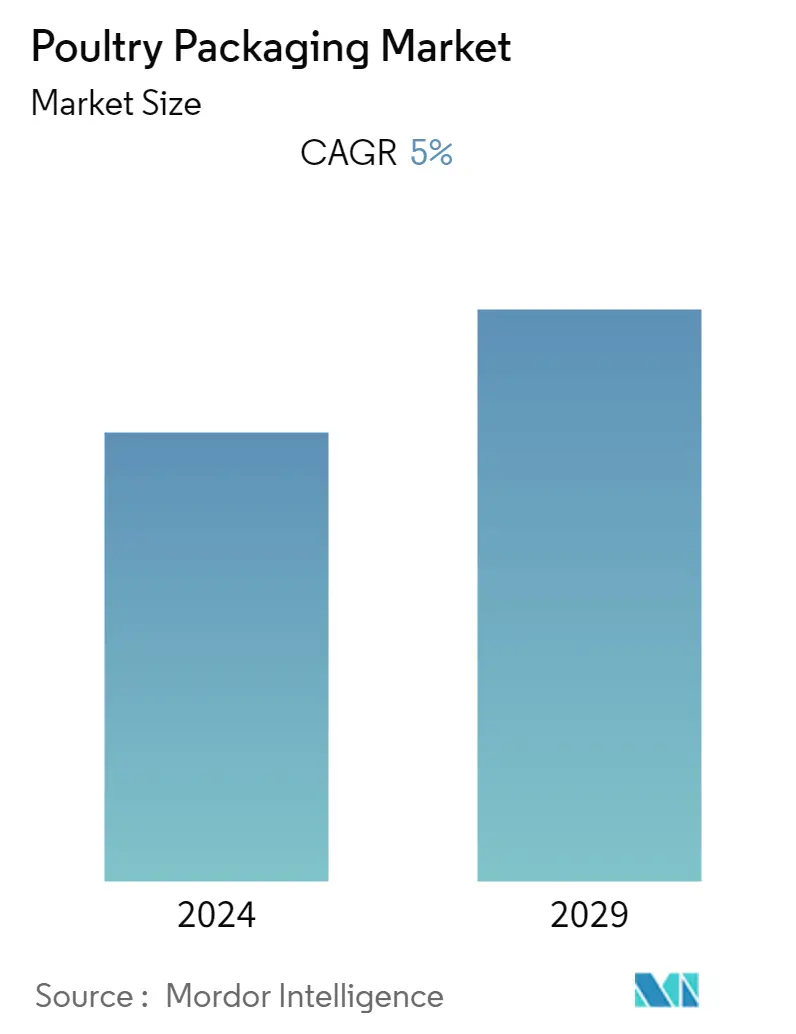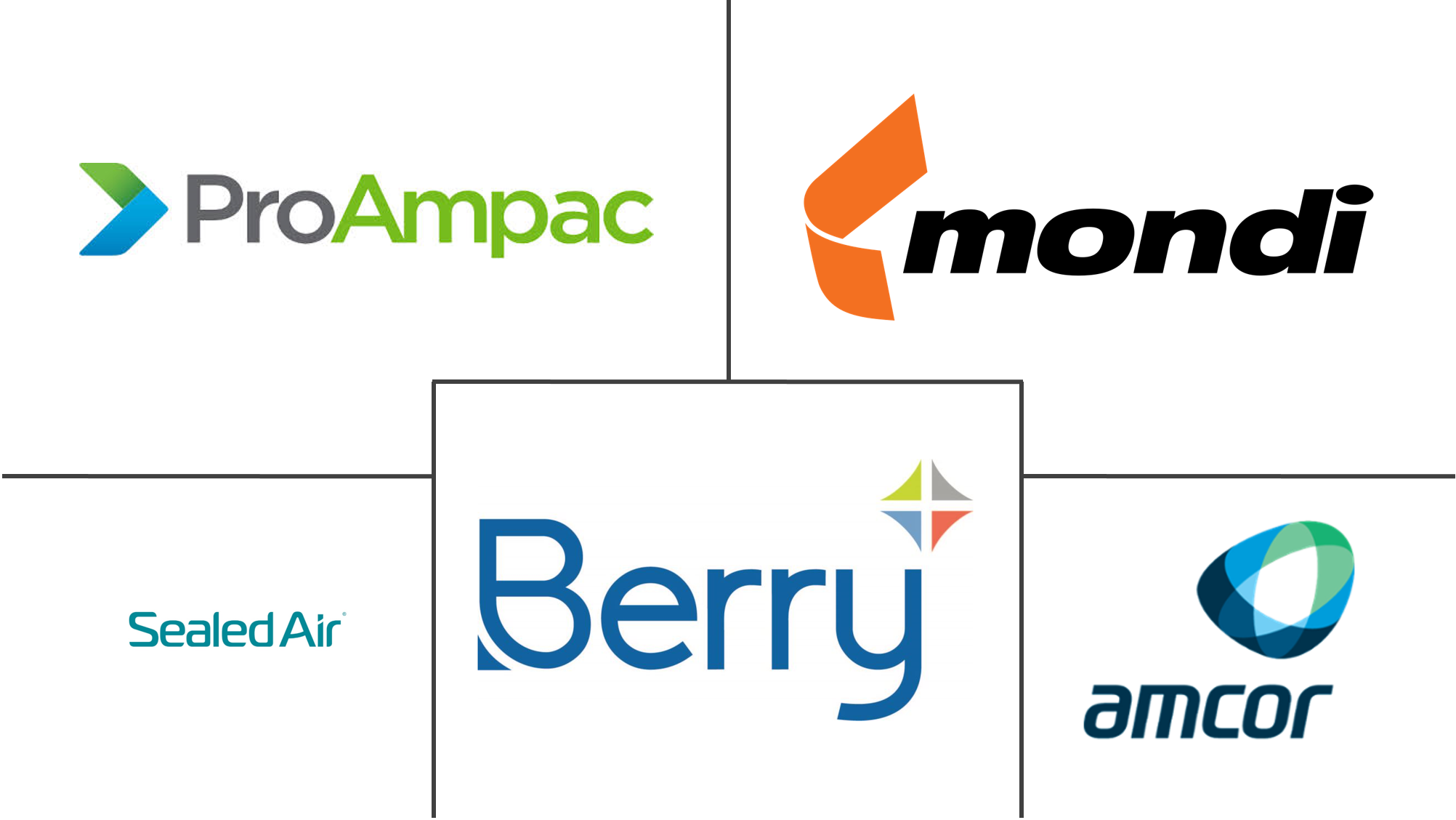Market Size of Poultry Packaging Industry

| Study Period | 2019 - 2029 |
| Base Year For Estimation | 2023 |
| CAGR | 5.00 % |
| Fastest Growing Market | Asia Pacific |
| Largest Market | North America |
| Market Concentration | Low |
Major Players
*Disclaimer: Major Players sorted in no particular order |
Poultry Packaging Market Analysis
The poultry packaging market is expected to register a CAGR of 5%, during the forecast period 2021 - 2026. The North American Meat Institute said that meat and poultry play critical roles in building strong bodies and healthy brains and in maintaining the bodies at every stage of life because they are the rich source of protein and contains several minerals such as iron, heme iron, and non-heme iron. Therefore, increasing awareness about nutrition from poultry meat is expected to be one of the major driving factors for the market to expand.
- Moreover, with the increasing demand for ready meals and convenience food with newer concepts like marinated wings, ready-to-cook thighs, and chickens infused with herbs and spices especially in rapidly urbanizing economies such as the United States, and China, are propelling the shrink bags and trays and bowls packaging to grow. This packaging provides the meats to be cooked on a direct flame and put on the table, all in the same container, which is being preferred by the consumers.
- Further, increasing consumer demand for convenience compels the retailers' to focus for longer shelf life in poultry food packaging. Thus, innovations in packaging are also offering more opportunities for meat manufacturers to differentiate their products from competing brands.
- For instance, ABP Food Group announced its new sustainable packaging for the European Region in October 2019. This packaging includes a recyclable card coupled with a thin film of peel away plastic, and this new packaging is expected to reduce 70% of the amount of plastics used to package its meat products. The company claims that such the new packaging technique would not impact the shelf-life of the meat. Such a sustainable packaging trend is expected to augment the market.
- However, the occurrence of disease epidemics like avian influenza and other infectious diseases coupled with the strict government regulations related to the packaging materials are hindering the market growth.
Poultry Packaging Industry Segmentation
Thepoultry packaging market gives a detailed analysis of packaging materials used for packagingdifferent poultry meat such as duck,chicken, and turkey. The report talks about fixed packaging materials such as trays and bowls, and cardboard whereas in flexibles, pouches, bags, and films are considered. On the basis of geography, North America, Europe, Asia-Pacific, Middle East & Africa, and Latin America are included in the report.
| By Meat | |
| Chicken Meat | |
| Turkey Meat | |
| Ducks Meat |
| By Packging | ||||||
| ||||||
| ||||||
|
| Geography | ||||||
| ||||||
| ||||||
| ||||||
| ||||||
|
Poultry Packaging Market Size Summary
The poultry packaging market is poised for significant growth, driven by increasing consumer awareness of the nutritional benefits of poultry meat and the rising demand for convenience foods. As urbanization accelerates in regions like the United States and China, there is a growing preference for ready-to-cook and marinated poultry products, which are packaged in innovative shrink bags, trays, and bowls. These packaging solutions not only enhance convenience but also cater to the consumer demand for longer shelf life, prompting retailers to focus on advanced packaging technologies. The market is further bolstered by sustainable packaging initiatives, such as those by ABP Food Group, which aim to reduce plastic usage without compromising product quality. However, challenges such as disease outbreaks and stringent regulations on packaging materials continue to pose obstacles to market expansion.
In North America, the poultry packaging market benefits from robust retail chains and a strong export presence, with increasing demand for barrier films to extend product shelf life. The market is characterized by competitive dynamics, with numerous global and local players striving to innovate and differentiate their offerings. The introduction of recyclable and reusable packaging solutions, like those from Royal DSM and Tosca, highlights the industry's shift towards sustainability. As the demand for packaged poultry products grows, opportunities for biodegradable and soluble films are also emerging. The market's competitive landscape is shaped by strategic acquisitions and collaborations aimed at enhancing product offerings and reducing environmental impact, as seen in recent developments by companies like LDC Group and Moy Park.
Poultry Packaging Market Size - Table of Contents
-
1. MARKET DYNAMICS
-
1.1 Market Overview
-
1.2 Introduction to Market Drivers and Restraints
-
1.3 Market Drivers
-
1.3.1 Increased Preference for Convenience Food Products
-
1.3.2 Increased Preference for Convenience Food Products
-
-
1.4 Market Restraints
-
1.4.1 Occurrence Of Disease Epidemics like Avian Influenza
-
-
1.5 Value Chain / Supply Chain Analysis
-
1.6 Industry Attractiveness - Porter's Five Force Analysis
-
1.6.1 Threat of New Entrants
-
1.6.2 Bargaining Power of Buyers/Consumers
-
1.6.3 Bargaining Power of Suppliers
-
1.6.4 Threat of Substitute Products
-
1.6.5 Intensity of Competitive Rivalry
-
-
-
2. MARKET SEGMENTATION
-
2.1 By Meat
-
2.1.1 Chicken Meat
-
2.1.2 Turkey Meat
-
2.1.3 Ducks Meat
-
-
2.2 By Packging
-
2.2.1 Fixed Packaging
-
2.2.1.1 Corrugated Cardboard
-
2.2.1.2 Trays and Bowls
-
2.2.1.3 Cans
-
2.2.1.4 Others
-
-
2.2.2 Flexibles Packaging
-
2.2.2.1 Shrinks Bags
-
2.2.2.2 Pouches
-
2.2.2.3 Barriers Films
-
2.2.2.4 Wrap
-
-
2.2.3 By Material
-
2.2.3.1 Plastics
-
2.2.3.2 Paper
-
2.2.3.3 Others
-
-
-
2.3 Geography
-
2.3.1 North America
-
2.3.1.1 United States
-
2.3.1.2 Canada
-
2.3.1.3 Rest of North America
-
-
2.3.2 Europe
-
2.3.2.1 Germany
-
2.3.2.2 United Kingdom
-
2.3.2.3 France
-
2.3.2.4 Rest of Europe
-
-
2.3.3 Asia-Pacific
-
2.3.3.1 China
-
2.3.3.2 Japan
-
2.3.3.3 India
-
2.3.3.4 Rest of Asia-Pacific
-
-
2.3.4 Middle East and Africa
-
2.3.4.1 UAE
-
2.3.4.2 Saudi Arabia
-
2.3.4.3 Rest of Middle East and Africa
-
-
2.3.5 Latin America
-
2.3.5.1 Brazil
-
2.3.5.2 Argentina
-
2.3.5.3 Rest of South America
-
-
-
Poultry Packaging Market Size FAQs
What is the current Poultry Packaging Market size?
The Poultry Packaging Market is projected to register a CAGR of 5% during the forecast period (2024-2029)
Who are the key players in Poultry Packaging Market?
Amcor plc, Berry Global, Inc, Mondi Group, Sealed Air Corporation and ProAmpac LLC are the major companies operating in the Poultry Packaging Market.

